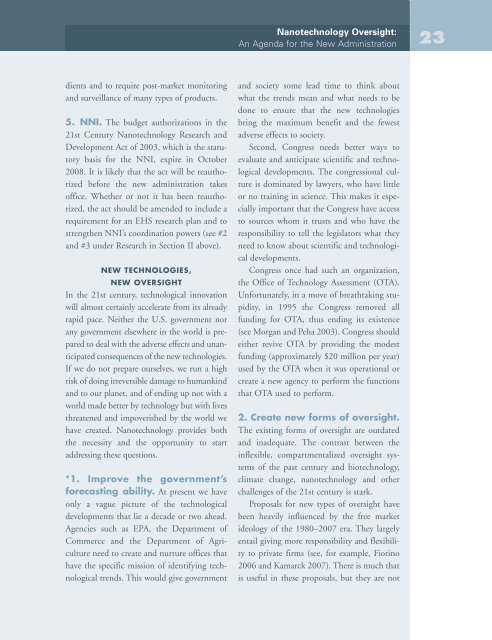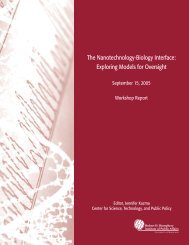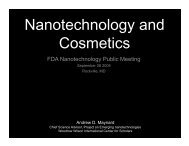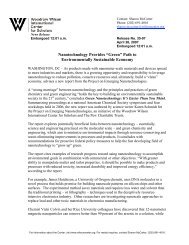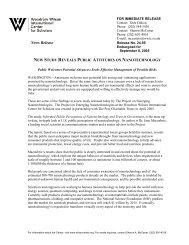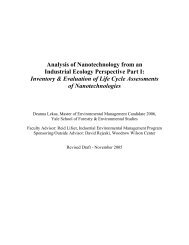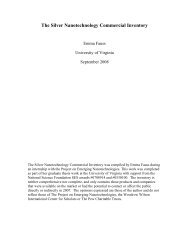nanotechnology oversight - Project on Emerging Nanotechnologies
nanotechnology oversight - Project on Emerging Nanotechnologies
nanotechnology oversight - Project on Emerging Nanotechnologies
Create successful ePaper yourself
Turn your PDF publications into a flip-book with our unique Google optimized e-Paper software.
Nanotechnology Oversight:<br />
An Agenda for the New Administrati<strong>on</strong><br />
23<br />
dients and to require post-market m<strong>on</strong>itoring<br />
and surveillance of many types of products.<br />
5. NNI. The budget authorizati<strong>on</strong>s in the<br />
21st Century Nanotechnology Research and<br />
Development Act of 2003, which is the statutory<br />
basis for the NNI, expire in October<br />
2008. It is likely that the act will be reauthorized<br />
before the new administrati<strong>on</strong> takes<br />
office. Whether or not it has been reauthorized,<br />
the act should be amended to include a<br />
requirement for an EHS research plan and to<br />
strengthen NNI’s coordinati<strong>on</strong> powers (see #2<br />
and #3 under Research in Secti<strong>on</strong> II above).<br />
NEW TECHNOLOGIES,<br />
NEW OVERSIGHT<br />
In the 21st century, technological innovati<strong>on</strong><br />
will almost certainly accelerate from its already<br />
rapid pace. Neither the U.S. government nor<br />
any government elsewhere in the world is prepared<br />
to deal with the adverse effects and unanticipated<br />
c<strong>on</strong>sequences of the new technologies.<br />
If we do not prepare ourselves, we run a high<br />
risk of doing irreversible damage to humankind<br />
and to our planet, and of ending up not with a<br />
world made better by technology but with lives<br />
threatened and impoverished by the world we<br />
have created. Nanotechnology provides both<br />
the necessity and the opportunity to start<br />
addressing these questi<strong>on</strong>s.<br />
*1. Improve the government’s<br />
forecasting ability. At present we have<br />
<strong>on</strong>ly a vague picture of the technological<br />
developments that lie a decade or two ahead.<br />
Agencies such as EPA, the Department of<br />
Commerce and the Department of Agriculture<br />
need to create and nurture offices that<br />
have the specific missi<strong>on</strong> of identifying technological<br />
trends. This would give government<br />
and society some lead time to think about<br />
what the trends mean and what needs to be<br />
d<strong>on</strong>e to ensure that the new technologies<br />
bring the maximum benefit and the fewest<br />
adverse effects to society.<br />
Sec<strong>on</strong>d, C<strong>on</strong>gress needs better ways to<br />
evaluate and anticipate scientific and technological<br />
developments. The c<strong>on</strong>gressi<strong>on</strong>al culture<br />
is dominated by lawyers, who have little<br />
or no training in science. This makes it especially<br />
important that the C<strong>on</strong>gress have access<br />
to sources whom it trusts and who have the<br />
resp<strong>on</strong>sibility to tell the legislators what they<br />
need to know about scientific and technological<br />
developments.<br />
C<strong>on</strong>gress <strong>on</strong>ce had such an organizati<strong>on</strong>,<br />
the Office of Technology Assessment (OTA).<br />
Unfortunately, in a move of breathtaking stupidity,<br />
in 1995 the C<strong>on</strong>gress removed all<br />
funding for OTA, thus ending its existence<br />
(see Morgan and Peha 2003). C<strong>on</strong>gress should<br />
either revive OTA by providing the modest<br />
funding (approximately $20 milli<strong>on</strong> per year)<br />
used by the OTA when it was operati<strong>on</strong>al or<br />
create a new agency to perform the functi<strong>on</strong>s<br />
that OTA used to perform.<br />
2. Create new forms of <str<strong>on</strong>g>oversight</str<strong>on</strong>g>.<br />
The existing forms of <str<strong>on</strong>g>oversight</str<strong>on</strong>g> are outdated<br />
and inadequate. The c<strong>on</strong>trast between the<br />
inflexible, compartmentalized <str<strong>on</strong>g>oversight</str<strong>on</strong>g> systems<br />
of the past century and biotechnology,<br />
climate change, <str<strong>on</strong>g>nanotechnology</str<strong>on</strong>g> and other<br />
challenges of the 21st century is stark.<br />
Proposals for new types of <str<strong>on</strong>g>oversight</str<strong>on</strong>g> have<br />
been heavily influenced by the free market<br />
ideology of the 1980–2007 era. They largely<br />
entail giving more resp<strong>on</strong>sibility and flexibility<br />
to private firms (see, for example, Fiorino<br />
2006 and Kamarck 2007). There is much that<br />
is useful in these proposals, but they are not


